Malcolm Barnes. Practical Variable Speed Drives and Power Electronics
Подождите немного. Документ загружается.

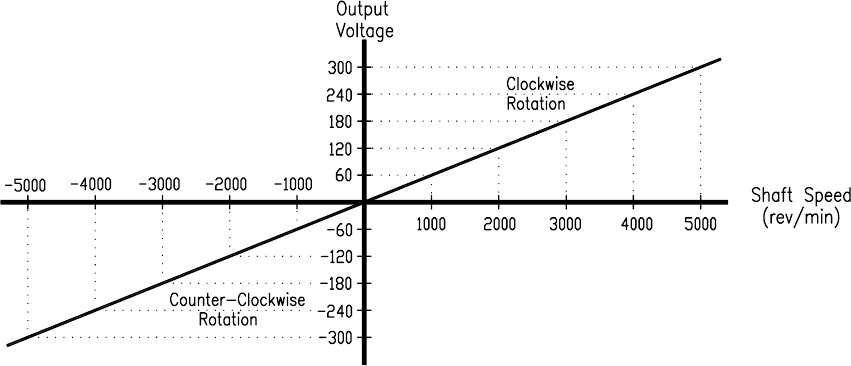
Speed measurement transducers
249
rotating, a mounting bracket is used to lock it to the bearing housing of the
machine.
Tacho-generators are available with DC or AC outputs as follows:
• The DC tacho-generator
This is a permanent magnet DC generator comprising a permanent magnet
stator with a wound rotor armature with commutator and brushes. The output
of the DC tacho is a DC voltage, whose magnitude is directly proportional to
the rotational speed of the motor and whose polarity depends on the direction
of rotation. Usually, the output voltage is arranged to be positive for
clockwise rotation and negative for counter-clockwise rotation.
Figure C.1:
The output voltage of a 60 volt/1000 rpm bi-directional DC tacho
A good quality DC tacho-generator should meet the following requirements:
− Output voltage precisely proportional to the speed of rotation in both
directions
− Negligible difference between the output voltage for specific speeds in
both the clockwise and counter-clockwise directions of rotation
− Stability of the output voltage in relation to temperature and time
− Low ripple in output DC voltage
− Small size with low moment of inertia of rotating parts
− Sturdy electrical and mechanical construction for high reliability
− Class of enclosure protection to suit industrial environment
− Low requirement for maintenance
− Adequate speed range for most common applications
250
Practical Variable Speed Drives and Power Electronics
When used for variable speed drive applications, tacho-generators are usually
rated for an output voltage of 60 volts per 1000 rpm (speed constant =
0.06 V/rpm) with a maximum speed of up to 5000 rpm. This results in a
maximum output voltage of up to 300 volts. However, other output voltages
and speed ranges are also available to suit specific requirements. The class of
protection of the tacho enclosure is usually specified to be the same as the
machine to which it is attached, e.g. IP54, IP55 or IP56.
• The AC tacho-generator
This is very similar to a DC tacho, except that the output is an alternating AC
voltage, whose magnitude and frequency is directly proportional to the
rotational speed. The AC voltage output is usually rectified and converted into
a DC voltage in the control system. Consequently, the AC Tacho is unsuitable
for bi-directional applications because the resulting voltage magnitude after
rectification is unipolar. Also, a high ripple content in the voltage signal at
low speed makes the AC Tacho unsuitable for low speed applications.
AC tacho-generators are seldom used with variable speed drives.
C.2 Digital rotary speed and position transducers
A digital rotary encoder is an electromechanical transducer, which converts rotary speed
or position into a series of digital electronic pulses. Rotary encoders are commonly used
for the following applications:
• Feedback of rotary speed from electric motors for variable speed drive control
• Determining the angular position of rotating machines for synchronizing
movements
• Tracking the position of robots, stackers, reclaimers and other automated
machines
• Monitoring the position of products on a conveyor
• Measuring the length of materials, which are fed from rolls, for cutting to size
The two main types of digital encoder are as follows:
• Incremental rotary encoder
Generates a series of square voltage pulses as the shaft rotates. External
electronic circuitry is required to determine the speed of rotation, direction,
angular position or length of material fed off a roll by counting the number of
pulses or measuring the rate at which they are transmitted by the encoder.
• Absolute rotary encoder
Generates a parallel code, comprising 4, 8, 12 or 16 bits, which represents the
angular position of the shaft. The Gray code is most commonly used for
absolute encoders. Occasionally, the binary or BCD code are also used.
C.2.1 Incremental rotary encoder
Incremental rotary encoders are the type most commonly used for VSDs and other
industrial positioning and synchronizing systems. The series of voltage pulses, which
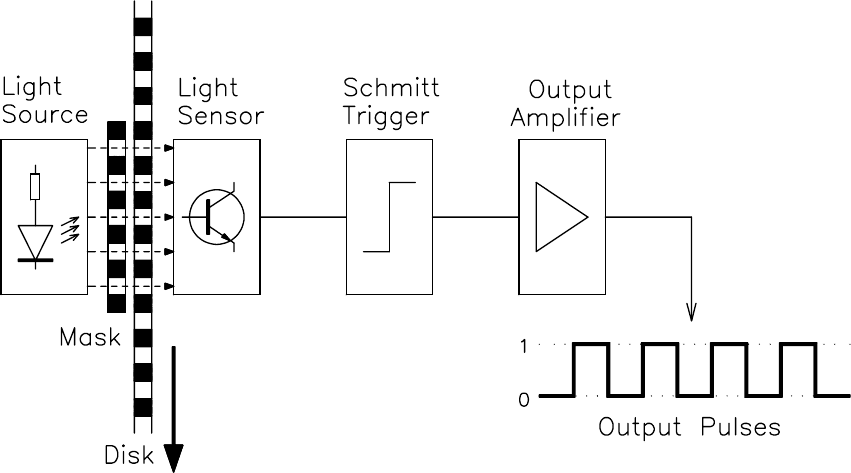
Speed measurement transducers
251
represent the rotational speed, are generated by the interaction of light from a light source
passing through a pattern of lines printed onto a transparent rotating disk.
The disk is usually made of a laminated plastic material to provide low weight and
inertia with a high resistance to mechanical shock. Some manufacturers use disks made of
glass, but these tend to be more fragile and heavier than the plastic types. Accurately
spaced lines, with spaces of identical width (space/width ratio = 1), are printed in a radial
pattern around the outer edges of the disk. Encoders with line counts of up to about
10 000 lines are available.
A beam of light, produced by an LED or miniature lamp with a focussing lens, is
passed through the graduated transparent disk and detected by a sensor on the other side.
Except for some very low rate incremental encoders, a stationary ‘mask’, with a line
pattern identical to that on the disk, is required to alternately block or pass the light beam
as the disk rotates. The intensity of the resulting light is sensed by a photo-cell
(transistor), which switches on when the light beam is passed and switches off when the
light beam is interrupted. This technique is known as the moire fringe principle.
Figure C.2:
The principle of an incremental encoder
The stationary mask usually has 3 separate fields, each with the same line spacing as
the rotating disk. Three photo-cells detect the presence/absence of light via these three
masks and pass the information to three output Channels. The first mask/sensor is for
Channel-A. The second mask/sensor is for Channel-B, which lags Channel-A by 90
o
. The
third mask/sensor is for the reference Channel-O, which provides one output pulse per
revolution.
A Schmitt Trigger squares off (digitizes) the electronic output of the photo-sensor
before passing the signal through an amplifier to produce a train of squared output pulses
with a constant amplitude. Amplitude is not important because the receiver is interested
only in the pulse rate and their phase relationship to each other.
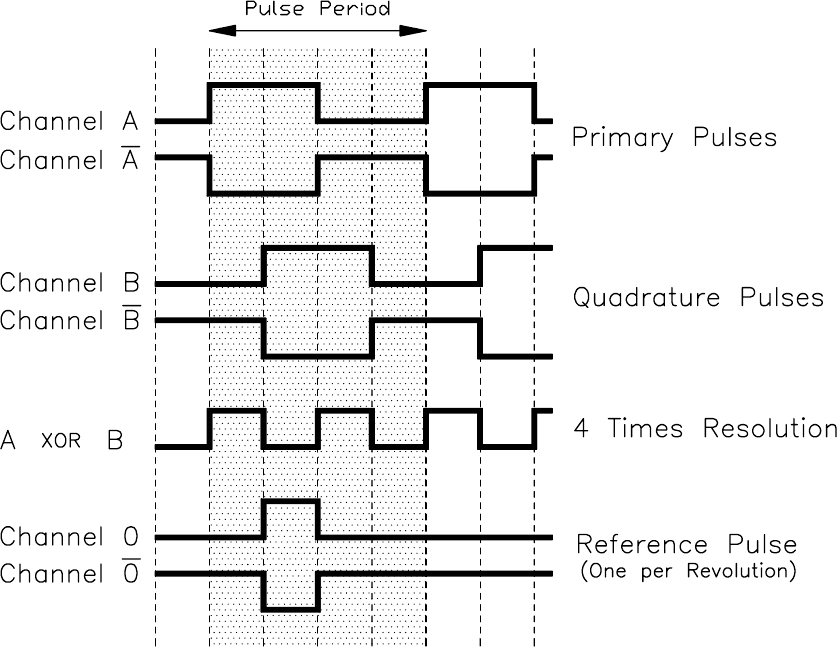
252
Practical Variable Speed Drives and Power Electronics
The rate of the digitized output pulses from an incremental encoder depends on:
• Resolution, the number of lines printed around the perimeter of the disk
This is normally specified as lines per revolution or pulses per revolution
(ppr). The resolution is sometimes also given as the angular distance between
two consecutive lines on the perimeter of the rotating disk.
• Rotational Speed, the rotational speed of the shaft of the machine
To measure rotational speed, an incremental rotary encoder requires only one track of
lines around the perimeter of the rotating disk, making it much simpler internally when
compared to an absolute encoder. The train of squared voltages is available from an
output Channel usually designated as Channel-A. An additional inverted signal
(complement of Channel-A), is usually available for signal noise immunity (see Section
C.2.3 on Output interfaces). The actual speed is measured by external electronic
equipment that uses up/down counters to determine speed and position. The external
electronic equipment usually also provides the power supply to the encoder.
Figure C.3:
Squared output pulses from a typical incremental rotary encoder
To measure direction, a second train of pulses is required from a similar Channel-B,
which is offset by 90
o
lagging relative to Channel-A. Channel-B is also known as the
quadrature Channel. The quadrature Channel-B uses the same track of lines on the disk
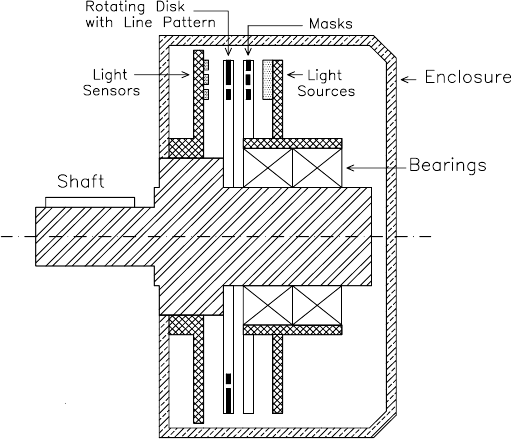
Speed measurement transducers
253
perimeter, but uses a separate mask grid with a 90
o
offset. An inverted Channel-B signal
is also usually provided.
The counters in the external electronic equipment monitor the relationship between
Channel-A and Channel-B to determine shaft speed and direction. This feature also
provides the ability to multiply the incremental value by four, using a built-in exclusive-
OR (XOR) gate, to increase the resolution.
For example, a incremental encoder with a line count of 10 000 can provide an output
of 40 000 steps per revolution.
• Clockwise direction is determined when Channel-A leads Channel-B by 90
o
• Counter-clockwise direction is determined when Channel-B leads Channel-A
by 90
o
The third Channel-O provides one output pulse per shaft revolution. This signal can be
used to synchronize the serial pulse train with a known mechanical position. In this case,
care should be taken during fitting to ensure that the position of the Channel-O pulse on
the disk is mechanically aligned with the required external reference point.
The following are common resolution values (ppr) for incremental rotary encoders:
2 4 8 16 32 36 48 50 60 90 100
120 125 128 150 180 200 250 256 300 320 360
375 400 420 480 500 512 600 625 720 800 900
1000 1024 1080 1100 1250 1270 1500 1600 1728 1750 1800
2000 2048 2400 2500 2540 2700 3000 3600 3750 4000 4096
4200 4500 5000 6000 6400 7200 8192 9000 10000
The physical arrangement of the components inside an incremental rotary encoder
depend on the manufacturer. A cross-section of a typical construction is shown below.
Figure C.4:
Physical arrangement of a typical incremental rotary encoder

254
Practical Variable Speed Drives and Power Electronics
C.2.2 Absolute rotary encoder
Single-turn absolute rotary encoders generate a parallel digital output, which represents
the angular position of the shaft over one revolution. Each angular position is represented
by a code, comprising several digital bits. The rotating optical disk has multiple tracks,
one for each bit of the output code. Even if the power fails, once restored, the position of
the shaft is accurately known without any resetting routine, as would be required for
incremental encoders.
One revolution (360
o
) is divided into a specified number of positions. The number of
possible positions (position resolution) depends on the number of tracks printed onto the
disk (number of bits in the code) as shown in the table on the next page.
No. of tracks
(bits in code)
Resolution
(No. of positions)
Resolution
(deg per position)
Resolution
(deg/min/sec)
1
2
3
4
5
6
7
8
10
12
16
2
4
8
16
32
64
128
256
1024
4096
65 536
180.00
o
90.00
o
45.00
o
22.50
o
11.25
o
5.63
o
2.81
o
1.41
o
0.35
o
0.088
o
0.0055
o
180
o
00’ 00’
90
o
00’ 00’
45
o
00’ 00’
22
o
30’ 00’
11
o
15’ 00’
5
o
37’ 30’
2
o
48’ 45’
1
o
24’ 23’
0
o
21’ 06’
0
o
05’ 16’
0
o
00’ 20’
Figure C.5:
The relationship between the number of tracks (bits) on the disk and the resolution of an absolute rotary
encoder
Absolute rotary encoders are available with outputs using one of the following codes:
• The binary code
• The binary coded decimal (BCD) code
• The Gray code
• The Gray excess code
Figure C.6 shows the 6-bit coded output signal for absolute encoders with 6 tracks
using the binary, BCD and Gray codes for a resolution of 36 positions (10
o
) over one
revolution. This sequence can be reduced or extended to match any required resolution.
The binary absolute encoder uses a binary number (counting system to the base 2) to
represent the position number of the shaft. This is best illustrated by way of an example.
Example:
What is the parallel 8-bit output code of an 8 track (256 position) single-turn
binary absolute encoder, which is stationary at a 270
o
shaft position?
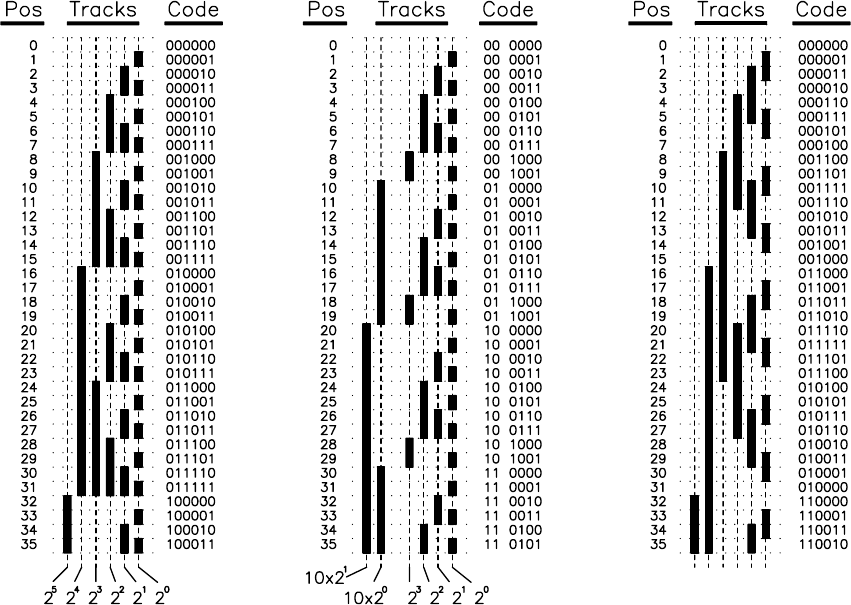
Speed measurement transducers
255
− An 8 track absolute encoder has 256 (2
8
) possible positions, numbered
0 to 255
− Position at 270
o
⇒ position-191
− The decimal position is converted to its equivalent in binary
− Position-191 ⇒ binary position code = 10111111
The procedure to convert any decimal number (base 10) to its equivalent
binary number (base 2) is to repeatedly divide the decimal number by 2 until
the quotient becomes zero.
Binary Code BCD Code Gray Code
Figure C.6:
6-bit binary, BCD and Gray codes for a resolution of 36 positions
The remainders at each stage are the individual bits of the binary number:
− 191/2 = 95, remainder 1 (least significant Bit or LSB)
− 95/2 = 47, remainder 1
− 47/2 = 23, remainder 1
− 23/2 = 11, remainder 1
256
Practical Variable Speed Drives and Power Electronics
− 11/2 = 5, remainder 1
− 5/2 = 2, remainder 1
− 2/2 = 1, remainder 0
− 1/2= 0, remainder 1 (most significant bit or MSB)
The remainder = 10111111, which is the 8-bit code for 270
o
The procedure to convert the binary position number back to its equivalent
decimal position number is much simpler. Each bit of the binary number
represents the multiplication factor of the exponents of base 2 as illustrated
below.
− Binary = 10111111
− Decimal = 1×2
7
+ 0×2
6
+ 1×2
5
+ 1×2
4
+ 1×2
3
+ 1×2
2
+ 1×2
1
+ 1×2
0
=
191
Although the binary code is used extensively in digital electronic equipment,
it has a major drawback for rotary encoders. As the shaft position changes
from one angular position to the next, several bits in the code are required to
change state simultaneously. For example, in Figure C.6, five bits change
state between position 15 to 16. If there are slight differences between the
switching times of the photo-cells reading the different tracks, the resulting
output code would represent a false position.
The BCD (binary coded decimal) code is an extension of the binary code. The four
least significant bits (LSB) of the BCD code follow the binary code, while the higher
order bits in the BCD code represent the decimal values as follows:
bit 1: 2
0
.(LSB)
bit 2: 2
1
bit 3: 2
2
bit 4: 2
3
bit 5: 10×2
0
bit 6: 10×2
1
bit 7: 10×2
2
bit 8: 10×2
3
.(MSB)
etc
The BCD code is the most convenient code to display shaft position on a set of 7-
segment LED modules. The 7-segment LED modules are usually arranged in a decimal
format with units on the right-hand side, then tens, then hundreds, then thousands, etc.
BCD encoders suffer from the same disadvantages as the binary encoders.
The Gray code is the preferred code for absolute encoders, particularly when used for
position control. The Gray code avoids the reading error problems associated with binary
and BCD encoders because only one bit changes between any two neighboring positions
(see Figure C.6). Reading error due to a slight misalignment of the photo-cells is reduced
to only 1 step.
However, when the required resolution (no. of positions) on an absolute rotary encoder
is a value less than 2
x
(where x = no. of tracks), several bits need to change at the zero
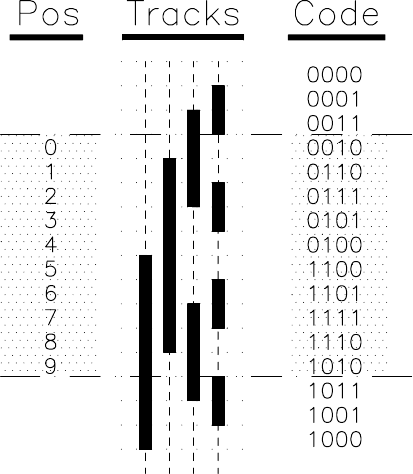
Speed measurement transducers
257
position of the disk and the Gray encoder would have the same disadvantages as the
binary encoder.
Figure C.7:
An example of the Gray excess code: 10-excess-3 Gray code
The Gray excess code has been developed to overcome this problem and consists of
only a middle portion of the Gray code. For example, with a 4 track absolute encoder, a
resolution of 2
4
(16 positions) is possible. If only 10 positions are required per revolution
and the Gray code was truncated after position 9, three bits would have to change to
return the code to position 0, as shown in Figure C.7. If the first 3 positions are omitted
from the pattern on the rotating disk and the following 10 positions used, then a change of
only 1 bit can be maintained for all positions of the disk. The Gray excess code for this
example would then be referred to as a 10-excess-3 Gray code.
Another common example is an absolute encoder, which uses the Gray excess code, is
one with a position resolution of 360 positions per revolution, or 1
o
per position. In this
case, a disk of at least 9 tracks is required to provide a 9-bit Gray code (2
9
= 512),
resulting in a 360-excess-76 Gray code.
Some industrial applications require an angular position resolution that is greater than
ONE revolution. In these cases, multi-turn absolute rotary encoders can be used to
distinguish between several revolutions. Additional graduated disks are provided with
mechanical reduction gearing between them.
The most common multi-turn absolute encoders use a parallel 24 bit Gray code,
comprising a main disk with 12 tracks (resolution = 2
12
or 4096) and up to 3 smaller
supplementary disks, each with 4 tracks and geared at a ratio of 16:1.

258
Practical Variable Speed Drives and Power Electronics
Figure C.8:
Example of multi-turn absolute encoder with 4 disks and gearing
With this arrangement, the following position and turns resolution can be achieved:
• 12 track main disk, resolution of 2
12
(4096 positions)
• 1 × 4 track supplementary disk, resolution of 2
4
(16 revolutions)
• 2 × 4 track supplementary disks, resolution of 2
4
× 2
4
(256 revolutions)
• 3 × 4 track supplementary disks, resolution of 2
4
× 2
4
× 2
4
(4096 revolutions)
180ppr Incremental Encoder Disk Absolute Gray Code Disk
Figure C.9:
Examples of disk patterns for incremental and absolute rotary encoders
